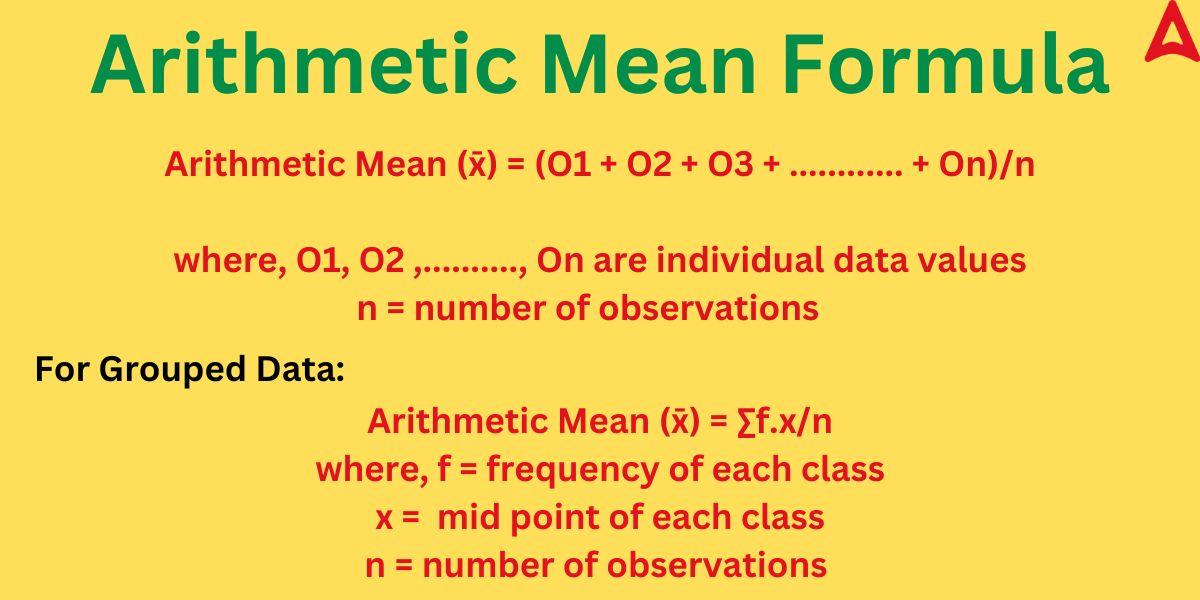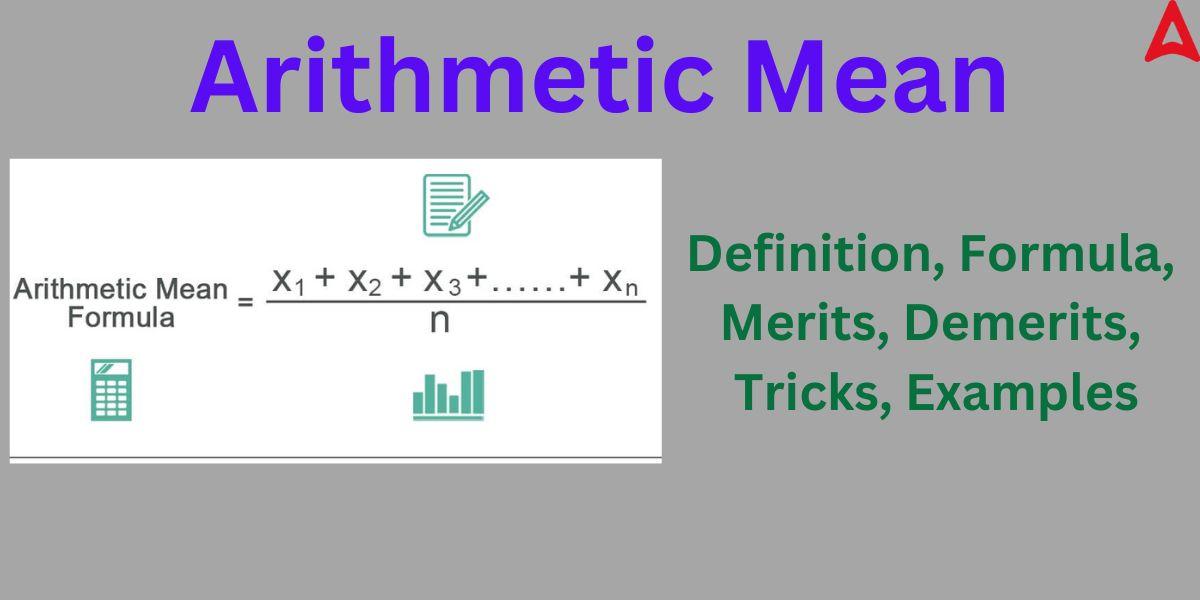The arithmetic mean is one of the most important concepts related to data operations that finds its usefulness in mathematics, statistics, economics, and all data-related domains. The arithmetic mean, commonly referred to as the “average,” is a key concept in statistics and mathematics. By identifying the central trend of a group of data points, it offers a technique to summarize the data. In this article, we will explore different aspects of this important concept.
Arithmetic Mean
The ratio of the sum of all observations to the total number of observations is known as the Arithmetic Mean (AM), often known as the average. It can be used to explain the central tendency of a dataset. It can be compared to a center of gravity in physical terms, where all the mass of a body is thought to be concentrated. This value is important in finding other statistical methods such as standard deviation and variance.
The mean value is determined by adding up each number in a particular data set, and then dividing the result by the overall number of items in the data set. For uniformly distributed integers, the middle number serves as the mean value. Additionally, the AM is estimated using a variety of techniques dependent on the volume and distribution of the data.
Arithmetic Mean Explanation
The concept of average tells us about the mean value of a given data points. For example, if we have given different data values of a dataset, then the average value means the single value by which we can replace the given data points. That means average value of mean value is the value that can account for all the given data points of a given dataset.
For instance, let’s say we’re interested in Delhi’s weather. On searching, you will get information about weather records from the past, information about the current weather, and projections for the weather in the future. These plethora of data might seem confusing for many. So, mathematicians and statisticians chose to utilize representative values that could account for a wide range of data in place of this lengthy list of data. We describe the weather over a period of about a month using terminology like average ( mean) to represent the weather for each specific day.
Arithmetic Mean Formula
The formula to derive the mean value can be obtained for different types of dataset. As stated earlier, the mean or average of an observation is given by the ratio of the sum of all the values and total number of values. The average or mean value is denoted by x̄. Let us understand its formula through an example.
Let us assume that there are 10 data points in an observation. The values of 10 data points are V1, V2, V3, ………, V10. We can derive the mean or average value of this observation by summing up the V1, V2, V3,…….. up to V10 and then dividing it by 10. i.e., x̄ = (V1 + V2 + …………..+ V10)/10.
The mean value is given by:
x̄ = (X1 + X2 + X3 + …………. + Xn)/n
where, x̄ = mean value
X1, X2, X3, ………… Xn = data values
n = number of observations
if the data values have frequencies associated with them, then the modified formula for the average becomes:
x̄ = (∑f. x)/n
where ∑f. x = is the sum of product all frequencies and their corresponding values. This is also known as weighted average value where f1, f2, f3, …..fn are the weights of x1, x2, x3, …….xn respectively.

Simple Arithmetic Mean
As stated earlier, the mean value can be found for both grouped (class-wise data) and ungrouped data (non class-wise data). In ungrouped data type, the data values can be present with frequencies or without frequencies. If the data values are without frequencies, then the average value of such data type is also known as simple arithmetic mean. The formula for the same is given below.
x̄ = sum of all observations/Total number of observations
Arithmetic Mean General Formula
The concept of mean or average is an important topic in all classes and competitive exams. Students studying mathematics and statistics must know about all the formulas relevant to the mean value. Some of the important general formulas of mean concept for board and competitive exam students are given hereunder.
- x̄ = sum of all observations/Total number of observations
- x̄ = (∑f. x)/n (for grouped data)
- x̄ = (a + b)/2, where a and b are two data values
Arithmetic Mean Using Assumed Mean Method
The assumed mean method to find the average value is used in case the general method (also known as direct method) for the grouped data becomes too lengthy. It is also known by the name “change of origin” method. The formula for this method is given by:
x̄ = A + (∑fi . di/∑fi), here summation takes place from i = 1 to n (total number of observations)
where x̄ = mean value
A = assumed mean value
fi = frequency of the ith class
di= deviation of the ith class = xi – A
The steps to find the mean of a dataset using this method is stated below.
Step 1: Calculate the mid-point xi of each class
Step 2: Chose any value from xi as the assumed mean A
Step 3: Determine the deviation (di) of each class by using the formula (di) = xi – A
Step 4: After getting all the values, use the formula for the assumed mean method to obtain the desired result
Mean Using Step Deviation Method
It is another method to find the mean value of a given dataset. It is also called change of scale or origin method. The formula for this method is given by:
x̄ = A + h × (∑fi . ui/∑fi)
x̄ = A + h × (∑fi . ui/∑fi), here summation takes place from i = 1 to n (total number of observations)
where x̄ = mean value
A = assumed mean value
fi = frequency of the ith class
h = class size
ui= (xi – A)/h
The steps to find the mean of a dataset using this method is stated below.
Step 1: Calculate the mid-point xi of each class
Step 2: Chose any value from xi as the assumed mean A
Step 3: Determine the deviation (ui) of each class by using the formula (di) = (xi – A)/h
Step 4: After getting all the values, use the formula for the step deviation mean method to obtain the desired result
Mean Advantages
Some of the advantages of this statistical tool is given below.
- It depends on the value of each observation or their frequency in the dataset
- It is firmly defined
- It is easy to understand and compute
- It is not affected by the change in position of the values
- It can be subjected to more algebraic processing.
Average Disadvantages
Some of the advantages of average value are stated hereunder.
- It is affected by extreme values which may not seem fit for the observation
- It is not possible to calculate the mean value through inspection or graph
- The mean value concept is not suitable for qualitative traits
- There is no full-proof method to calculate the mean value in open-end classes
Average Tricks
Some of the tricks related to this concept is given below. One must go through this concept to solve arithmetic mean questions in less time.
- The mean value of a symmetric data set is always the middle value
- If each value of the observation is multiplied by k, then the mean value also becomes k times the original value
- If each value of the observation is divided by k, then the mean value becomes 1/k times the original value
- Step deviation is suitable when there are a significant number of class intervals and a clustered frequency distribution with a constant width for each class interval.
Properties of Arithmetic Mean
The five properties of the mean value is listed below.
- The sum of deviations from the average value is always zero.
- The average value is located centrally. That is, more than any other single statistic, the mean value is closest to the majority of the observations.
- The average value are independent of the scalar variations. This indicates that scaling the data has no impact on the mean value
- The average of any dataset is additive in nature. This indicates that a mean’s value is the total of its means.
- The sum of squared deviations from the average value is minimized. In other words, the total of the squares of the deviations of each observation from the mean is less than if the mean were changed to any other number.
Arithmetic Mean Solved Examples
Some of the solved examples related to this topic is given below. These solved questions will help students in understanding this concept in a concrete way.
Example 1: Find the mean of the given data values: 1, 5, 7, 35, 4, 2
Solution: Given values = 1, 5, 7, 35, 4, 2
number of observations (n) = 6
sum of all the observations = 1 + 5 + 7 + 35 + 4 + 2 = 54
as mean = sum of all observations/number of observations
so, mean = 54/6
Hence, mean = 9
Example 2: If the average of certain values are given to be 50 and the sum of observations is given to be 750, then find out the number of data points present in the dataset.
Solution: Given, mean = 50
sum of observations = 750
as we know, mean = sum of all observations/number of observations
so, 50 = 750/n
n = 750/50
n = 15
Hence, number of observations = 15
Example 3: The mean values of a given dataset is 13. If the values are given to be 5, 11, 30, 6, 8, 14, x. Find out the value of x.
Solution: Given mean = 13
number of observations (n) = 7
as mean = sum of all observations/number of observations
13 = (5 + 11 + 30 + 6 + 8 + 14 + x)/7
13 = (74 + x)/7
13 x 7 = 74 + x
x = 91 – 74
x = 17












 Greater Than and Less Than, Equal to Sig...
Greater Than and Less Than, Equal to Sig...
 XXV Number- XXV Roman Numerals Definitio...
XXV Number- XXV Roman Numerals Definitio...
 Ordinal Numbers: Meaning, Examples, Appl...
Ordinal Numbers: Meaning, Examples, Appl...









